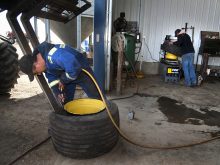Audiologist says the number of cases has increased in the last few years, but treatment available if caught soon enough
When Gordon Sampson couldn’t hear anything in his left ear, at first he blamed his hearing aid.
Considering it was seeding time, he hadn’t even noticed when the problem had initially started, but by the time he made an appointment with an ear, nose and throat specialist, there was nothing to be done to treat the sudden hearing loss on his left side.
“I got in to see the doctor right away,” said Sampson, who farmed near Davidson, Sask.
“He went in and did his basic tests and said that I was deaf. He put me on prednisone right away, but that didn’t help in my case.”
Read Also

Fuel rebate rule change will affect taxes and AgriStability
The federal government recently announced updates to the fuel rebates that farmers have been receiving since 2019-20.
The number of cases of sudden hearing loss has been growing in the last few years, said Jason Schmiedge, Hearing Life Canada’s regional manager for Saskatchewan and northeastern Alberta. A few months ago, Hearing Life clinics across Saskatchewan collectively reported six cases of sudden hearing loss in one week, he said, which is startling considering infrequent cases usually appear randomly.
A prednisone treatment is available and effective within 72 hours. This small window of time is why people have to get in to see their doctor as soon as they notice the problem, Schmiedge said, because there is nothing that can be done after that window closes.
“Excess pressure in the cochlea, or organ of hearing, where these delicate hairs are and with that excess fluid pressure in the cochlea, those delicate little hair cells that amplify sound get permanently damaged if they’re not caught quickly enough.”
Sudden hearing loss is typically caused by a viral infection, which is why it only affects hearing in one ear instead of both, said Schmiedge. Hearing damage cannot be repaired, he added, and hearing aids won’t help if the patient is permanently deaf.
There is little research into why the infection happens, or why numbers are increasing, he added, which is why he has been on a mission to raise awareness about how to treat the problems. A presentation to 40 physicians in December has already proven beneficial, he said.
“Four days after I did that presentation, someone went in with a sudden hearing loss, was given prednisone and then we tested a couple of weeks after and his hearing was fine…(The patient) said, ‘when I went in and said the symptoms, the doctor said I know exactly what to do.’ ”
Schmiedge said ear, nose and throat specialists are always on call to help with the diagnosis if doctors aren’t comfortable prescribing a prednisone shot.
Sampson said he already had hearing trouble before the 2010 incident. Being left-handed, he wasn’t surprised when he needed a single hearing aid for his left side after years of not wearing hearing protection when hammering away in his machine shop.
Even though one-sided deafness didn’t bother him too much while working alone on the farm, he said it has been an adjustment when having conversations with people and needing to turn his good ear to the sound.
“You don’t have that surround sound. If something comes up on your back left side and you don’t hear anything, you get startled.”
Before retiring in 2022, Sampson said he started being more careful with his remaining hearing, consistently using ear protection during farm work and working with Schmiedge to move his hearing aid to his right ear.















